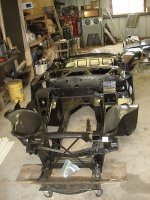Offline
I think we all/mostly agree that the big Healey has a weak frame. Especially after about 50 or 60 years. The car was built light. And we can reenforce the frame but that is not a prefect answer. A new frame is the best answer. But can we or will we all go that far. I would not cut the frame apart to try to hide the repair because ultimately you probably won't be hiding it anyway. So hears my answer in leu of a new frame, Think street rod. On an earlier project I boxed the inside of the frame on a Model A Ford. Those old frames were an open C Channel with the open side towards the middle. You would weld plate to the inside of the c channel to box it closed so that you could weld in new cross members for newer suspensions. The advantage to the Model A frame was that it was open and you could scrap it, clean it, and paint it. One of the bad things about a Healey frame is that it is completely closed in and almost imposible to treat. And guess what? It ain't going to get any stronger. If you want to attempt to repair an existing frame, you can buy replacement main channels. Or they can be made from approprately sized rectangular tubing. Thant's still a chalenge getting them in right and will certainly have an effect as to any originality or concours. Thats why I would give consideration getting them up and straight and precisely cutting and fitting plate to the sides of the main rails and "Welding Plate".Johnny said:vette said:I would say, jack it up, make it straight then box the frame with plate. It's never going to be concours now. OR! buy a new frame from Martin.
If the car has just begun to sag it is possible to extend the life of the car by plating it from the inside. I've seen this done with 3" square tubing inside the frame. By cutting open the top of the frame from inside the cockpit area and folding it open you can insert a box tube inside, then cut circles about 3/4" round on the original frame then weld the old box frame to the new box frame from the outside around the circles. Then seal up the top opening and you are good to go. It is virtually undetectable unless you look under the car and up the side of the frame. Does any of this make sense?

 Hi Guest!
Hi Guest!

 smilie in place of the real @
smilie in place of the real @
 Pretty Please - add it to our Events forum(s) and add to the calendar! >>
Pretty Please - add it to our Events forum(s) and add to the calendar! >> 







